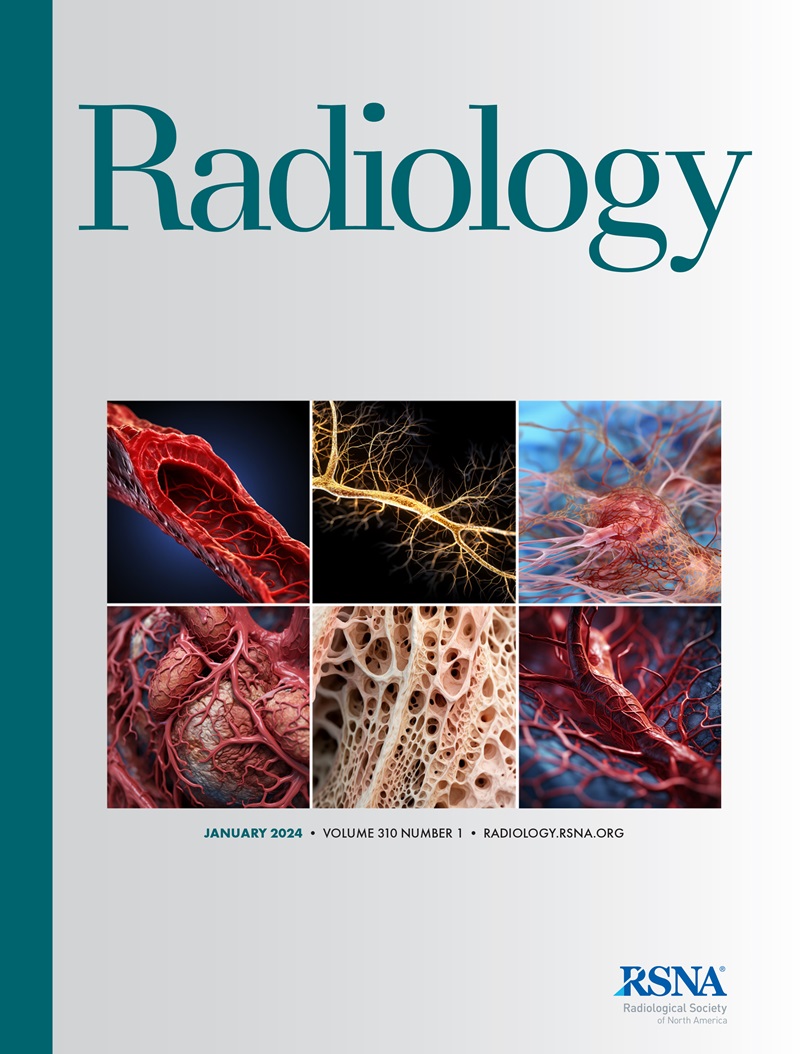易感性MRI有助于预测轻度认知障碍的发病和认知能力下降的老年人认知功能未受损。
IF 15.2
1区 医学
Q1 RADIOLOGY, NUCLEAR MEDICINE & MEDICAL IMAGING
引用次数: 0
摘要
脑铁升高是神经退行性变的潜在标志物,但其在预测轻度认知障碍(MCI)发病和预期认知轨迹方面的作用尚不清楚。目的探讨定量易感性成像(QSM) MRI和PET检测脑铁和淀粉样蛋白β (Aβ)水平对MCI发病和认知能力下降的预测作用。在2015年1月至2022年11月进行的这项前瞻性研究中,认知功能未受损的老年人接受了基线QSM MRI检查。在大多数具有基线PET数据(PET亚组)的患者中,测量皮质β负荷。使用Cox回归和线性混合效应模型来检查基线组织易感性与MCI发病时间和认知评分随时间变化之间的关系。结果158名认知功能正常的老年人(平均年龄69.5岁±8.1岁[SD],女性99名),其中110人(平均年龄68.5岁±8.5岁,女性69名)接受PET检查,在基线时进行评估,随访时间长达7.7年。在整体组和PET亚组中,内嗅皮质和壳核较高的基线易感性与MCI发病风险增加相关(内嗅皮质,整体组与PET亚组:风险比分别为2.00 [95% CI: 1.23, 3.23; P = 0.005]和3.59 [95% CI: 1.70, 7.57; P < 0.001])。此外,在PET亚组中,随着时间的推移,内嗅皮层较高的基线易感性(总体而言,β = -0.020[平均标准误差,0.008;P = 0.01];内嗅皮层β = -0.022[平均标准误差,0.008;P = 0.008];壳核β = -0.018[平均标准误差,0.008;P = 0.04])与更大的整体认知能力下降有关,特别是在淀粉样蛋白异常存在的情况下。结论内嗅皮层和壳核组织磁化率升高是认知功能正常的老年人发生轻度认知障碍和认知能力下降的重要预测因子,尤其是淀粉样神经病理异常的老年人。©RSNA, 2025本文可获得补充材料。另见Andreu Arasa在本期的社论。本文章由计算机程序翻译,如有差异,请以英文原文为准。
Susceptibility MRI Helps Predict Mild Cognitive Impairment Onset and Cognitive Decline in Cognitively Unimpaired Older Adults.
Background Elevated brain iron is a potential marker for neurodegeneration, but its role in predicting onset of mild cognitive impairment (MCI) and prospective cognitive trajectories remains unclear. Purpose To investigate how brain iron and amyloid-β (Aβ) levels, measured using quantitative susceptibility mapping (QSM) MRI and PET, help predict MCI onset and cognitive decline. Materials and Methods In this prospective study conducted between January 2015 and November 2022, cognitively unimpaired older adults underwent baseline QSM MRI. Among the majority with baseline PET data (PET subgroup), cortical Aβ burden was measured. Cox regression and linear mixed-effects models were used to examine associations between baseline tissue susceptibility and time to MCI onset and changes in cognitive scores over time. Results A total of 158 cognitively unimpaired older adults (mean age, 69.5 years ± 8.1 [SD]; 99 women), including 110 individuals (mean age, 68.5 years ± 8.5; 69 women) with data from a PET examination, were evaluated at baseline and followed for up to 7.7 years. Higher baseline susceptibility in the entorhinal cortex and putamen was associated with an increased risk for MCI onset in the overall group and in the PET subgroup (entorhinal cortex, overall group vs PET subgroup: hazard ratio, 2.00 [95% CI: 1.23, 3.23; P = .005] vs 3.59 [95% CI: 1.70, 7.57; P < .001], respectively). In addition, in the PET subgroup, higher baseline susceptibility in the entorhinal cortex (overall, β = -0.020 [standard error of the mean, 0.008; P = .01]; in the entorhinal cortex, β = -0.022 [standard error of the mean, 0.008; P = .008]; and in the putamen, β = -0.018 [standard error of the mean, 0.008; P = .04]) was associated with greater global cognitive decline over time, particularly in the presence of amyloid abnormality. Conclusion Increased tissue magnetic susceptibility in the entorhinal cortex and putamen is a significant predictor of onset of mild cognitive impairment and cognitive decline in cognitively unimpaired older adults, especially those with amyloid neuropathologic abnormalities. © RSNA, 2025 Supplemental material is available for this article. See also the editorial by Andreu Arasa in this issue.
求助全文
通过发布文献求助,成功后即可免费获取论文全文。
去求助
来源期刊

Radiology
医学-核医学
CiteScore
35.20
自引率
3.00%
发文量
596
审稿时长
3.6 months
期刊介绍:
Published regularly since 1923 by the Radiological Society of North America (RSNA), Radiology has long been recognized as the authoritative reference for the most current, clinically relevant and highest quality research in the field of radiology. Each month the journal publishes approximately 240 pages of peer-reviewed original research, authoritative reviews, well-balanced commentary on significant articles, and expert opinion on new techniques and technologies.
Radiology publishes cutting edge and impactful imaging research articles in radiology and medical imaging in order to help improve human health.
 求助内容:
求助内容: 应助结果提醒方式:
应助结果提醒方式:


